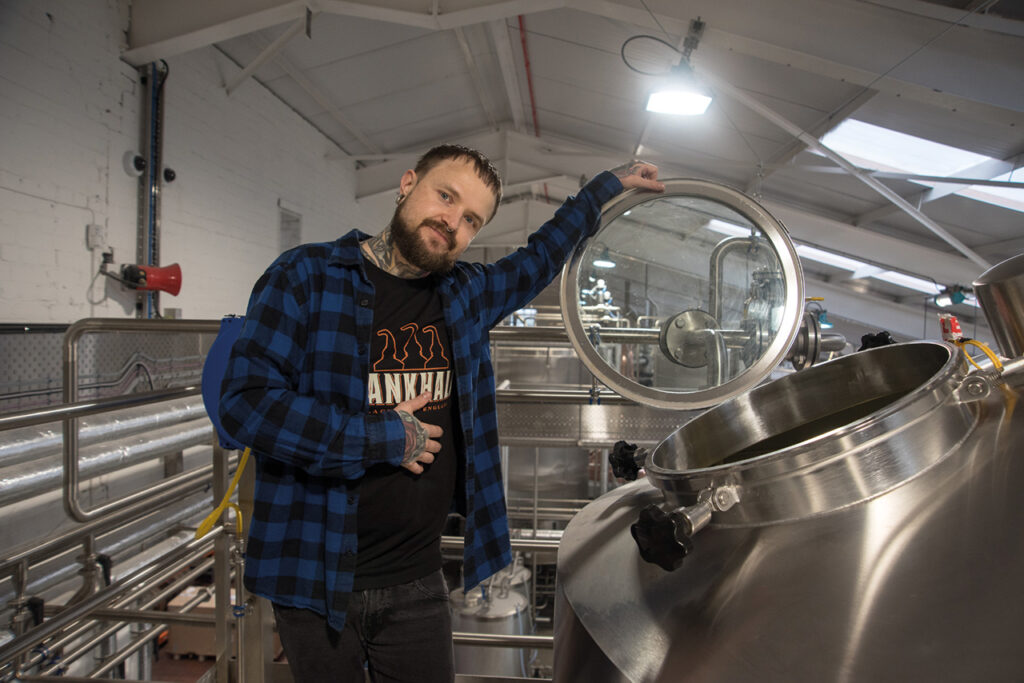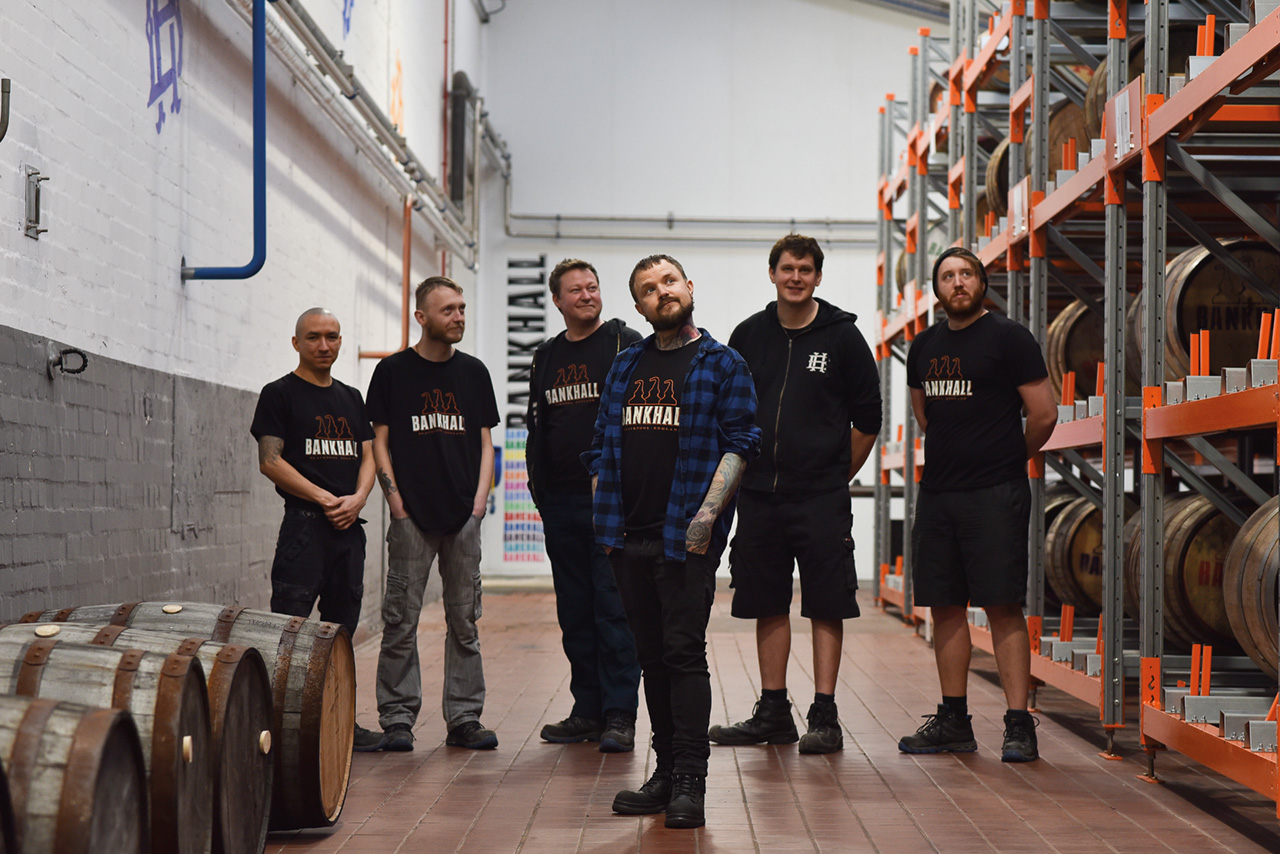Grist to the mill
There’s a flavour of the American South in what head distiller Vince Oleson and his team are making at Bankhall. The Sweet Mash is the first step in ambitions to redefine English whisky making
Last month JJ Whitley’s artisanal vodka went from being “remarkably Russian” to “quintessentially British” overnight, when its parent company Halewood shut up shop in St Petersburg and moved its operation to Chorley, Lancashire.
“We’re gritty and irreverent in our whisky making and Blackpool has a similar vibe.”
It’s the kind of unlikely move that one Halewood employee already knew something about. Vince Oleson was head distiller at a craft whisky distillery, Widow Jane in Brooklyn, New York, when the spirits manufacturer responsible for the likes of Dead Man’s Fingers rum and Whitley Neill gin came knocking. Its proposition – to bring his expertise 3,000 miles across the Atlantic and set up the first British bourbon-style whisky distillery, Bankhall, on an industrial estate in Blackpool, just 30 miles from where it’s shifted its vodka production.
“I know. It’s a bit crazy. It made sense at the time. I was looking to grow and I’d already kind of felt like I hit the ceiling where I was before and I was just looking to take a leap and do something more brave,” says Oleson from the cavernous heart of the operation on Burton Road – so called for once being the home of Burton’s Biscuits. That site is now occupied by Valeo Confectionery, which today produces barrel loads of wine gums, fruit pastilles and fizzy cola bottles. Oleson’s barrels continue this sweet theme. Bankhall’s first small batch release is a triple-distilled Sweet Mash – named after the process, starting fresh each time, of mashing corn, rye and malt into a hearty foundation for the spirit.
“The opportunity came across my plate and was too good to pass up,” says Oleson. “I was really excited about the chance to help redefine English whisky. That’s very cool because so much of what has been produced until recently has been single malt, so very much similar to Scotch, and I feel like there’s a lot more that can be said for it.
“The definition is very broad and so we are able to really allow for more innovation within that field and help make English whisky something that stands on its own, through some American-style inspiration.”
Although there are more than 1,500 barrels of the stuff here, none of it is in fact whisky yet, and nor is it bourbon.
“Where I’m from whisky is whisky the day you put it in the barrel, but here it’s not whisky until it’s three years and a day old, and technically bourbon has to be made in the US so what we do is bourbon style.
“Basically if you were to take this plan and move it into the middle of America, you could call all of this bourbon. Bourbon is defined by 51 per cent corn in the recipe and aged in new charred American oak casks. We follow the same rules but the third requirement is that it’s made in America.
“It’s not all we do though. We are also distilling single malts and using speciality casks. We do like this bourbon profile but it’s part of talking about what more we can do with English whisky and it’s our first avenue of exploring that. We have this tag line, Adventures in Distilling, and we want to live up to that.”
That sense of adventure is apparent at the entrance to Bankhall Distillery where a “badass” Indian-make American motorcycle stands emblazoned with Bankhall branding. It’s a perk of the job for Oleson, but the Arizona native says he’s “a bit of a baby” when it comes to riding it against northern coastal winds and only takes it out in the summer months. Why did the company choose Blackpool?
“We’re gritty and irreverent in our whisky making and I think Blackpool has a similar vibe, hence the graffiti throughout the distillery which was all done by local artist Seca One, who’s a bit of a Blackpool legend.
“Plus, we wanted to be set in a space we can actually grow into. We’ve already expanded next door and there’s talk about maybe expanding even more. There was just more room for us to stretch up here.”

Bankhall is no small operation, although Oleson insists that it is “craft”, which he defines by attention to quality rather than producing limited quantities. Last year he and his team of five made over 110,000 litres of pure alcohol.
“Compared to Jack Daniels it’s not that much, but for us we’re really proud of that,” says Oleson, who looks and sounds every bit the Brooklyn hipster, but is as warm and unpretentious a host as any Lancashire landlord. “We filled over 1,000 barrels and those are 200 litres or more each. My previous role as head distiller of Widow Jane was smaller scale comparatively so the opportunity here was just too unique. There was a lot of freedom for me to grow and learn as well, and that’s my jam.”
It’s not just a scholastic pursuit, however. Although the bar upstairs is currently reserved for hosting sales reps and other suits, there’s a real party vibe throughout the distillery floor. During a week of downtime for the machines each of the staff members, including Oleson, takes meticulous pride in making sure the stainless steel fermentation vessels and copper stills shine like new pennies to a booming eclectic soundtrack of everything from house to rock music.
Dave Conway, lead mashman – essentially the cook, he says – is the only one who doesn’t fight for control of the sound system. Among the other employees is a drummer, Tom Lunn, and a classical guitarist, Joan Casals – both distillers. But Conway has designs on an intimate live gig in the distillery to mark its first major bourbon-style whisky launch, in winter 2023, and knows a thing or two about being a fun-gi (he’s a doctor of biomolecular scientist, specialising in mycology).
“A big part of the process here is making sure this is a fun place to come to. We’re making whisky – you know, it should be fun,” says Oleson. He arrived from New York to set up the distillery in November 2019, alongside Conway and lead stillman Craig Drake, and they started producing in March 2020. He says the project kept them sane during the toughest months of the pandemic.
“It was our escape from the madness. It’s funny, I come from a country where alcohol was illegal and then essential in the course of a century, which is kind of amazing. We were essential workers. It was a safe place to work – we’ve got tons of room so we could practice social distancing, plus there was no shortage of alcohol to sanitise your hands.”
In an act of inspired geekery the team named all the major pieces of equipment in the distillery after Star Wars characters and Oleson uses them as markers during his tour – something he is considering doing more of following Bankhall’s first major launch.
First, in the yard, is Jabba – “not the sexiest bit of kit” – the effluent tank.
“We are all about sustainability, so the end waste product comes to this vessel. There are still some nutrients, a bit of nitrogen, so we work with local farmers who take this away and spread it on their fields to revitalise their soil.”
Everything, apart from Bankhall’s corn – and its head distiller of course – is sourced as locally as possible. Wholegrains are milled on site and, standing proudly adjacent to Jabba, are three 30-tonne silos – holding wheat, corn, malt and sometimes rye.
“As local as we can get our corn with the dependable quality that we need is France – it’s just too wet in England to have a crop that isn’t too moisture heavy.” And Oleson reasons there’s poetic justification for importing it. The bourbon name itself has French origins and, he points out, it was originally shipped down the Mississippi River to French customers in New Orleans.
The brewhouse is lovingly referred to as the Millennium Falcon – where Conway spends most of his time with Han Solo (a mash kettle so called because it often works alone) and Chewy (a lauter tun whose zig-zagged teeth work like a large sieve to separate the solids from the liquids).
From there the mash is transferred into six 20,000 litre fermenters. Currently, Bankhall is operating at a 50 per cent capacity on a 12-hour day but will soon become a 24-hour operation, doubling its output to 50 casks per week.
The first of the three imposing copper stills is Vader, which Oleson says “breathes” out the low wines – the oily product of the first distillation. From there they are transferred into Luke for their second distillation.
Then the experts must decide how much of the distillate to collect – known as making cuts. “At this point we want to get a lot of character out of it, so we have to do a wide cut,” explains Oleson. “First we collect the heads [the first compounds released with the lowest boiling point], and then we’re into the good part, called the hearts, so we make the cut there. Then, when we get to the lower alcohol, the heavier oils and other heavier congeners, we cut back to tails.
“I only want to put the best part forward and so this cut is what we’ll carry on to the third distillation and the rest gets reused.”
Bankhall’s finishing still is, of course, Leia. From her, everything goes to a barrelling vessel and the casks are filled. The whole process takes less than a week but once the whisky hits the barrel, work of equal importance begins.
“The maturation side of it is where we want these casks to be working. They’re not just resting – they’re actually actively breathing and allowing the whisky to flow in and out of the pores of the wood,” says Oleson. “The barrels expand and contract with the seasons so we don’t have any air conditioning in here and in the summer it gets quite hot. That’s good. The barrels will swell up and, in the winter, they get colder and push that whisky out of the wood and back into the actual barrel. That process happening over and over again allows us to create colour, balance and character.”
Like its hometown, character is something Bankhall distillery, its whisky and the small team that lovingly produces it have in double measures.
If you’re a widget-making start-up your widgets are available from day one. If you’re a new publishing company you go live when the first edition is ready. But if you’re a distillery you just have to wait.
Although there’s no minimum age requirement for bourbon, good whisky needs time in the barrel but the people who make it understandably want to get their stuff out there. Hence Bankhall’s Sweet Mash, released without an age statement but undeniably very young.
There’s sweet honey on the nose, almost perfumed, liqueur-like. The characteristic bourbon aroma of charred oak is present but very restrained. A little later, it’s smelling more like a raw young brandy than bourbon.
The flavours are interesting: brazil nuts and coconut at first, and then a slightly bitter medicinal note of cloves. A hint of bourbon returns.
This is perhaps more suited to cocktail making than sipping at the moment and would go well in a mint julep or old-fashioned. But everything’s present and correct for later versions and it’s a good statement of intent from Bankhall.
Kevin Gopal
